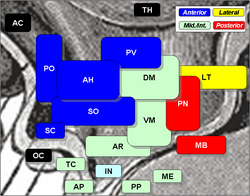
The hypothalamus is a part of the brain that contains a number of small nuclei with a variety of functions. One of the most important functions is to link the nervous system to the endocrine system via the pituitary gland. The hypothalamus is located below the thalamus and is part of the limbic system. In the terminology of neuroanatomy, it forms the ventral part of the diencephalon. All vertebrate brains contain a hypothalamus. In humans, it is the size of an almond.

The arcuate nucleus of the hypothalamus is an aggregation of neurons in the mediobasal hypothalamus, adjacent to the third ventricle and the median eminence. The arcuate nucleus includes several important and diverse populations of neurons that help mediate different neuroendocrine and physiological functions, including neuroendocrine neurons, centrally projecting neurons, and astrocytes. The populations of neurons found in the arcuate nucleus are based on the hormones they secrete or interact with and are responsible for hypothalamic function, such as regulating hormones released from the pituitary gland or secreting their own hormones. Neurons in this region are also responsible for integrating information and providing inputs to other nuclei in the hypothalamus or inputs to areas outside this region of the brain. These neurons, generated from the ventral part of the periventricular epithelium during embryonic development, locate dorsally in the hypothalamus, becoming part of the ventromedial hypothalamic region. The function of the arcuate nucleus relies on its diversity of neurons, but its central role is involved in homeostasis. The arcuate nucleus provides many physiological roles involved in feeding, metabolism, fertility, and cardiovascular regulation.

Neuropeptide Y (NPY) is a 36 amino-acid neuropeptide that is involved in various physiological and homeostatic processes in both the central and peripheral nervous systems. It is secreted alongside other neurotransmitters such as GABA and glutamate.

Lordosis behavior, also known as mammalian lordosis or presenting, is the naturally occurring body posture for sexual receptivity to copulation present in females of most mammals including rodents, elephants, and cats. The primary characteristics of the behavior are a lowering of the forelimbs but with the rear limbs extended and hips raised, ventral arching of the spine and a raising, or sideward displacement, of the tail. During lordosis, the spine curves dorsoventrally so that its apex points towards the abdomen.

Octreotide, sold under the brand name Sandostatin among others, is an octapeptide that mimics natural somatostatin pharmacologically, though it is a more potent inhibitor of growth hormone, glucagon, and insulin than the natural hormone. It was first synthesized in 1979 by the chemist Wilfried Bauer, and binds predominantly to the somatostatin receptors SSTR2 and SSTR5.

The ventrolateral preoptic nucleus (VLPO), also known as the intermediate nucleus of the preoptic area (IPA), is a small cluster of neurons situated in the anterior hypothalamus, sitting just above and to the side of the optic chiasm in the brain of humans and other animals. The brain's sleep-promoting nuclei, together with the ascending arousal system which includes components in the brainstem, hypothalamus and basal forebrain, are the interconnected neural systems which control states of arousal, sleep, and transitions between these two states. The VLPO is active during sleep, particularly during non-rapid eye movement sleep, and releases inhibitory neurotransmitters, mainly GABA and galanin, which inhibit neurons of the ascending arousal system that are involved in wakefulness and arousal. The VLPO is in turn innervated by neurons from several components of the ascending arousal system. The VLPO is activated by the endogenous sleep-promoting substances adenosine and prostaglandin D2. The VLPO is inhibited during wakefulness by the arousal-inducing neurotransmitters norepinephrine and acetylcholine. The role of the VLPO in sleep and wakefulness, and its association with sleep disorders – particularly insomnia and narcolepsy – is a growing area of neuroscience research.

The stria terminalis is a structure in the brain consisting of a band of fibers running along the lateral margin of the ventricular surface of the thalamus. Serving as a major output pathway of the amygdala, the stria terminalis runs from its centromedial division to the ventromedial nucleus of the hypothalamus.
The sexually dimorphic nucleus (SDN) is an ovoid, densely packed cluster of large cells located in the medial preoptic area (POA) of the hypothalamus which is believed to be related to sexual behavior in animals. Thus far, for all species of mammals investigated, the SDN has been repeatedly found to be considerably larger in males than in females. In humans, the volume of the SDN has been found to be 2.2 times as large in males as in females and to contain 2.1 times as many cells. The human SDN is elongated in females and more spherical in males. No sex differences have been observed in the human SDN in either cell density or mean diameter of the cell nuclei. The volume and cell number of the human SDN considerably decreases with age, although the decrease in cell number is both sex and age-specific. In males, a substantial decrease in the cell number of the human SDN was observed between the age of 50–60 years. Cell death was more common in females than males, especially among those older than 70 years of age. The SDN cell number in females can drop to 10-15% of that found in early childhood.

A vagotomy is a surgical procedure that involves removing part of the vagus nerve. It is performed in the abdomen.

The dorsomedial hypothalamic nucleus is a nucleus of the hypothalamus. It is involved in feeding, drinking, body-weight regulation and circadian activity. More specifically, it is a necessary component for the expression of numerous behavioral and physiological circadian rhythms. The dorsomedial hypothalamic nucleus receives information from neurons and humors involved in feeding regulation, body weight and energy consumption, and then passes this information on to brain regions involved in sleep and wakefulness regulation, body temperature and corticosteroid secretion.

The preoptic area is a region of the hypothalamus. MeSH classifies it as part of the anterior hypothalamus. TA lists four nuclei in this region,.
The periventricular nucleus is a thin sheet of small neurons located in the wall of the third ventricle, a composite structure of the hypothalamus. It functions in analgesia.
In evolutionary psychology, people often speak of the four Fs which are said to be the four basic and most primal drives that animals are evolutionarily adapted to have, follow, and achieve: fighting, fleeing, feeding and mating.
Neuromedin U is a neuropeptide found in the brain of humans and other mammals, which has a number of diverse functions including contraction of smooth muscle, regulation of blood pressure, pain perception, appetite, bone growth, and hormone release. It was first isolated from the spinal cord in 1985, and named after its ability to cause smooth muscle contraction in the uterus.

Coumestrol is a natural organic compound in the class of phytochemicals known as coumestans. Coumestrol was first identified as a compound with estrogenic properties by E. M. Bickoff in ladino clover and alfalfa in 1957. It has garnered research interest because of its estrogenic activity and prevalence in some foods, including soybeans, brussels sprouts, spinach and a variety of legumes. The highest concentrations of coumestrol are found in clover, Kala Chana, and Alfalfa sprouts.

SB-334867 is an orexin antagonist. It was the first non-peptide antagonist developed that is selective for the orexin receptor subtype OX1, with around 50x selectivity for OX1 over OX2 receptors. It has been shown to produce sedative and anorectic effects in animals, and has been useful in characterising the orexinergic regulation of brain systems involved with appetite and sleep, as well as other physiological processes. The hydrochloride salt of SB-334867 has been demonstrated to be hydrolytically unstable, both in solution and as the solid. Orexin antagonists have multiple potential clinical applications including the treatment of drug addiction, insomnia, obesity and diabetes.
Parabiosis is a laboratory technique used in physiological research, derived from the Greek word meaning "living beside." The technique involves the surgical joining of two living organisms in such a way that they develop a single, shared physiological system. Through this unique approach, researchers can study the exchange of blood, hormones, and other substances between the two organisms, allowing for the examination of a wide range of physiological phenomena and interactions. Parabiosis has been employed in various fields of study, including stem cell research, endocrinology, aging research, and immunology.
David Booth works full-time in research and research teaching as an honorary professor at the School of Psychology in the College of Life and Environmental Sciences of the University of Birmingham (UK). According to his Web page he investigates the ways in which an individual's life works. His research and teaching centre on the processes in the mind that fit acts and reactions of human beings and animals to the passing situation.

Pathophysiology of obesity is the study of disordered physiological processes that cause, result from, or are otherwise associated with obesity. A number of possible pathophysiological mechanisms have been identified which may contribute in the development and maintenance of obesity.
Dayu Lin is a neuroscientist and Associate Professor of Psychiatry, Neuroscience and Physiology at the New York University Grossman School of Medicine in New York City. Lin discovered the neural circuits in the hypothalamus that give rise to aggression in mice. Her lab at NYU now probes the neural circuits underlying innate social behaviors, with a focus on aggressive and defensive behaviors.











